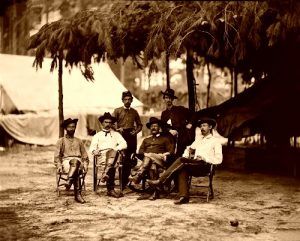The Peninsula Campaign, also known as the Peninsular Campaign, was a Union offensive that took place from March through July 1862 with the intention of capturing Richmond. The strategic concept was the brainchild of Union Army Commander-in-Chief Major General George B. McClellan, who felt his Army of the Potomac could avoid high casualties by not marching south on Richmond from northern Virginia but rather by moving by water. The first large-scale offensive in the Eastern Theater, McClellan made arrangements with the Union Navy to first transport his army to the Peninsula, then, continuing on via the James and York Rivers, the army’s flanks would be protected as they advanced.
The Army of the Potomac had approximately 50,000 men at Fort Monroe when McClellan arrived, but this number grew to 121,500 before hostilities began. Transporting these men, almost 15,000 horses and mules, and 1,150 wagons was an enormous task. It required 113 steamships, 188 schooners, and 88 barges.
Though the plan seemed extremely sound and its advantages seemingly made McClellan’s forces unstoppable, the Commander would not achieve his goals.
Though McClellan was initially successful against General Joseph E. Johnston, the emergence of General Robert E. Lee changed the character of the campaign and turned it into a humiliating Union defeat.
It was in these final battles, known as the Seven Days Battles, occurring from June 25 to July 1, with Lee in command of the Confederates, that the tides were turned to McClellan on the defense.
The tenacity of Lee’s attacks and the sudden appearance of Stonewall Jackson’s “foot cavalry” on his western flank unnerved McClellan, who pulled his forces back to a base on the James River. Lincoln later ordered the army to return to the Washington, D.C., area to support General John Pope’s army in the Northern Virginia Campaign and the Second Battle of Bull Run.
In the end, the Union would suffer some 15,000 casualties to the Confederate’s 19,000.
The Peninsula Campaign included the following battles:
- Hampton Roads (March 8-9, 1862)
- Yorktown (April 5-May 4, 1862)
- Williamsburg (May 5, 1862)
- Eltham’s Landing (May 7, 1862)
- Drewry’s Bluff (May 15, 1862)
- Hanover Courthouse (May 27, 1862)
- Seven Pines (May 31-June 1, 1862)
- Oak Grove (June 25, 1862)
- Beaver Dam Creek (June 26, 1862)
- Gaines’ Mill (June 27, 1862)
- Garnetts & Goldings Farm (June 27-28, 1862)
- Savage’s Station (June 29, 1862)
- White Oak Swamp (Virginia, June 30, 1862)
- Glendale (June 30, 1862)
- Malvern Hill (July 1, 1862)
Compiled and edited by Kathy Alexander, updated January 2024.
Also See:


